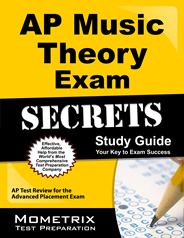AP Music Theory Exam Study Guide
Advance Placement Music Theory (or AP Music Theory, AP Jams, AP Music, or even Music AP) is a course and examination offered in the United States by the College Board as a feature of the Advanced Placement Program to secondary school understudies who wish to procure credit for a school level music hypothesis course.
Syllabus of the AP Music Theory Exam
A portion of the material secured in the course includes low sight perusing, inside and out wording, musical expressing and creation, music history, harmony structure and rhythms, and different ranges of music hypothesis. This course is prescribed for understudies with especially solid capacities in music and school music majors.
Format of the AP Music Theory Exam
The exam itself is isolated into two expansive areas: Section I, the different decision segment, and Section II, the free-reaction area. In turn, every area is isolated into parts.
Area I - Multiple Choice
Segment I of the exam comprises of four-decision numerous decision addresses; the aggregate sum fluctuates every year. The primary a large portion of the area is listening-based; the delegate will start playing a gave CD, and the exam will start. Every inquiry or gathering of inquiries is based on a musical choice or a sound-related jolt. The determination or boost will be played, and the understudy must reply the same number of the inquiries as would be prudent. Every musical choice or sound-related boost is typically played a few times for every inquiry or gathering of inquiries, however the accurate number contrasts from inquiry to question.
Area II - Free Response
Area II of the exam comprises of three distinct parts, all of which are understudy delivered reactions. One piece of the segment is listening-based, one section is part-written work, and one section is sight-singing. The listening-based piece of the segment contains two sorts of inquiries: melodic transcription, in which an one-section song is played two or three times, a beginning pitch, time mark, and key are given on the answer sheet, and the understudy should precisely record both the pitch and length of the played notes. The understudy must record two songs; by and large, one tune is in a noteworthy key and in a compound meter while the other song is in a minor key and in a basic meter. One tune is composed in the treble clef and the other is in the bass clef. The principal melodic correspondence inquiry is in straightforward meter, while the second melodic inquiry is in compound time. The purpose behind this is to test hopeful AP Music Theory understudies in their capacity to recognize basic and compound time marks and having the capacity to peruse bass clef and treble clef. The second sort of listening-based inquiry is symphonic transcription. A four-section composition, conventional SATB, is played four times. The key, beginning pitch for every part, and time mark are given on the answer sheet. The understudy should precisely manage just the bass and soprano lines, however the bass, tenor, alto, and soprano parts are being played on the recording. The understudy should likewise give a Roman numeral examination of the harmonies played in the movement played. The part-composing piece of area II obliges that the understudy, utilizing information of "eighteenth century structure rules" (as shown on College Board's most recent rubric and on the discharged 2003-2006 exams on AP Central), "standard" harmony movements, rhythms, voicing, and part ranges, compose a short (generally two or four measure) two- or four-section composition given beginning pitches, a key, time mark, and another bit of data that fluctuates with every inquiry: figured bass documentation and finished bass part, Roman numeral documentation, or a finished soprano line.
For the inquiry with the supplied figured bass documentation and finished bass line, the understudy must compose the Roman numeral documentation of every harmony and fill in the staying tenor, alto, and soprano lines. For the inquiry with the supplied Roman numeral documentation, the understudy must compose every one of the four sections of the composition. For the inquiry with the supplied soprano line, the understudy must build up a harmony movement taking into account the given soprano line and compose just a going hand in hand with bass part.
The sight-singing piece of the exam requires the understudy to investigate a given melodic line and perform the line as precisely as could reasonably be expected. Understudies perform two tunes each one in turn; the composed beginning pitch will be played, and the understudy will have 75 seconds to practice so anyone might hear any parts he or she craves. Once the 75 seconds have finished, the beginning pitch will be played once more, and the understudy will have 30 seconds to perform the piece. Transposition of the key is considered voice ease as expressed on every year's bearings. Similarly as with the melodic correspondence piece of the exam, one piece will for the most part be compound in meter and real in key, while the other will be basic in meter and minor in key. Understudies may sing the song utilizing solfège syllables, numbers, or an arbitrary syllable (la,la,la...ta,ta,ta etc...
Study Guide And Test Preparation For AP Music Theory Exam
A Complete AP Music Theory Exam Study Guide that includes sample questions, test tips and a complete study plan prepared by a team of expert and dedicated researchers. Cost-effective and qualified exam help from a committed exam preparation company.
AP Music Theory Exam Secrets (printed book)

